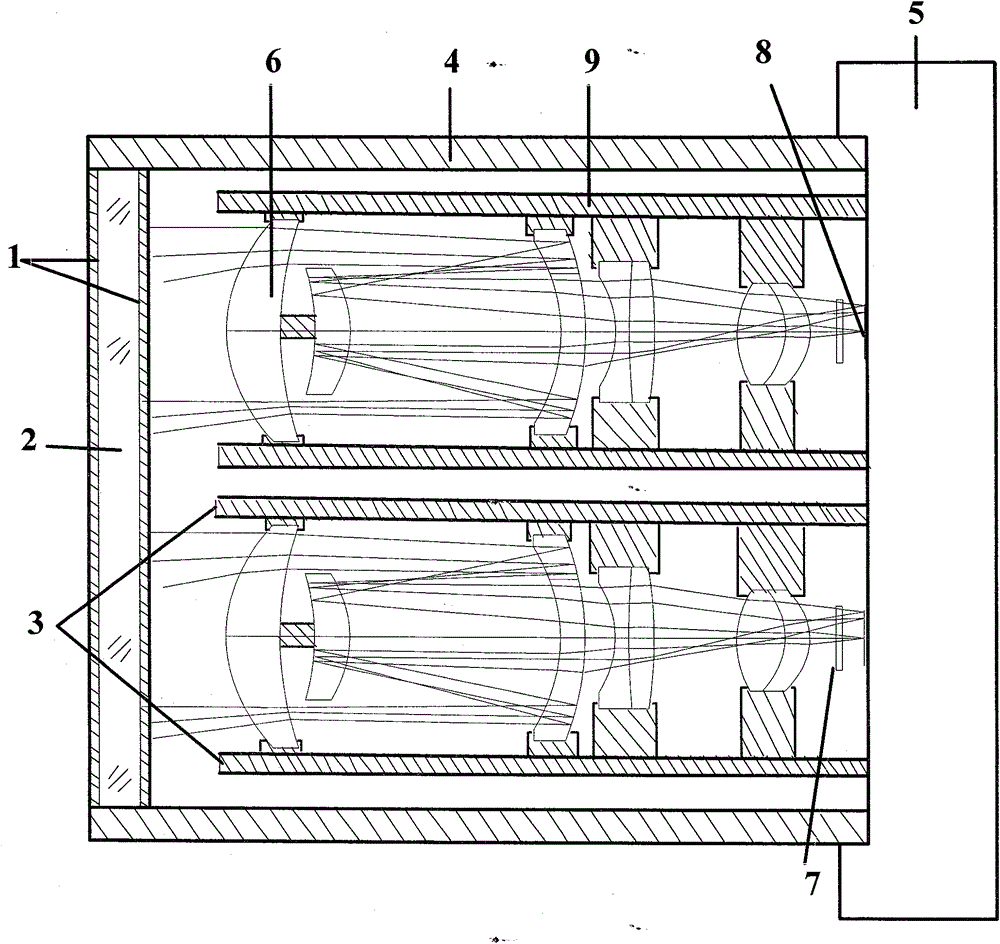Near-space airborne-to-ground real-time imaging system
A real-time imaging system and imaging system technology, applied in the field of ground real-time imaging systems, can solve the problems of reduced sensitivity, high cost, and increased cost, and achieve the effects of strong pertinence, high accuracy and strong timeliness
- Summary
- Abstract
- Description
- Claims
- Application Information
AI Technical Summary
Problems solved by technology
Method used
Image
Examples
Embodiment 1
[0027] Example 1: Optical window
[0028] Airborne ground real-time imaging system consists of figure 1 As shown, it includes: optical camera array, airborne data processing system and image transmission equipment for real-time transmission, the hood is installed on the shell of the imaging system, and the hood is installed on the top of the hood with an openable and closed function.
[0029] Composed of quartz glass windows (optical windows), in order to adjust the attitude of the camera array in real time and avoid the influence of aircraft platform flip, pitch, roll, etc. on camera imaging, the optical camera and quartz glass windows are installed on a closed mechanical turntable.
[0030]The optical window provides the optical signal entrance for the imaging system and meets the requirements of the field of view. When the system is imaging, the imaging light enters the optical system through the optical window and is imaged on the CCD imaging focal plane. Since the optica...
Embodiment 2
[0037] Example 2: Optical Camera Array
[0038] The optical camera array consists of four identical optical cameras. Specifically, the structure of the optical camera array is as follows figure 2 shown.
[0039] Since the payload is carried on the UAV aircraft in the near space, the distance from the ground is relatively long. In order to clearly obtain the geographical information of the ground target, a larger focal length and a larger clear aperture are required. The longer the focal length of the system, according to the imaging principle, the larger the image of the target on the detector after passing through the optical system, the easier it is to identify. But the volume of the system is directly proportional to the size of the focal length, the longer the focal length, the larger the volume of the system. For this reason, the structural form of the optical lens in the optical camera of the patent of the present invention adopts a catadioptric structure, and its str...
Embodiment 3
[0078] Embodiment 3: Image acquisition and acquisition
[0079] The target light enters the camera through the optical window (2), focuses the target on the linear array CCD detector (8), and converts the optical signal into an electrical signal; then converts it into a digital signal through an analog / digital converter (A / D) ;Then the signal is compressed by the microprocessor (MPU) and converted into a specific image file format and stored on the memory card, and transmitted to the airborne data processing system through the output interface, and the target signal is solidified to a camera motherboard. Large-scale integrated circuit chips collect and process the charge information accumulated by the CCD during the imaging process, and compress, display and store the obtained scene images. The camera adopts an advanced data acquisition and processing system, which can improve the overall operation response speed and computing power of the imaging system, and can process a lar...
PUM
 Login to View More
Login to View More Abstract
Description
Claims
Application Information
 Login to View More
Login to View More - R&D Engineer
- R&D Manager
- IP Professional
- Industry Leading Data Capabilities
- Powerful AI technology
- Patent DNA Extraction
Browse by: Latest US Patents, China's latest patents, Technical Efficacy Thesaurus, Application Domain, Technology Topic, Popular Technical Reports.
© 2024 PatSnap. All rights reserved.Legal|Privacy policy|Modern Slavery Act Transparency Statement|Sitemap|About US| Contact US: help@patsnap.com










